Nurturing the QUEST for Service Delivery Excellence through 10 Quality Commandments
Quality was, is and will always be a cutting edge differentiator for customer propositions. A four-decade of my fortunate association with different sectors and industries has witnessed this. However, its manifestation through different industrial eras will continue to evolve.
A decade of the last stint with Service Sector saw a consolidation of the learnings into this compilation – set of ‘Ten Quality Commandments (10 QCs) for the QUEST of Superior Service Delivery, which we will be sharing one-by-one every day, starting tomorrow.
The Structure of 10 QCs will nurture the culture of QUEST: troika of QUality consciousness, Envisaging efforts and STakeholders synergy.
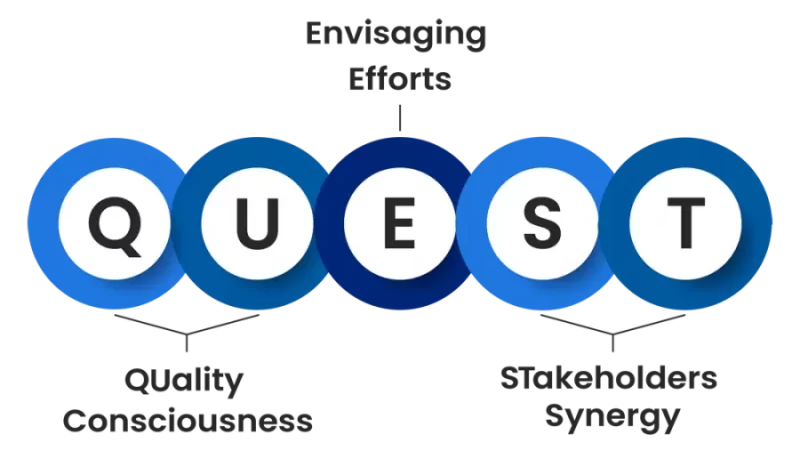 |
Quality-consciousness implies being observant about the gaps viz-a-viz standards and finding and fixing them, first time right. Envisaging-effort indicates foreseeing future, thinking proactively and acting pre-emptively. Stakeholder-synergy involves building-maintaining enduring stakeholder relationships and leveraging them for seamless-ceaseless service delivery.
Anyone responsible for Customer Advocacy/ Service Delivery (and none will be not), should find these important ingredients, hearty and handy to contend and contain the VUCAtmosphere in a contemporary context.
QC1 – One Common Definition: Quality exists when Experience Exceeds Expectations
1st Quality Commandment, the core purpose of any business, reflects the essence of various philosophies put forward by world’s renowned Quality Gurus like Deming, Juran, Crosby, Kano and others. It also relates to the latest Quality Definition by ISO – “Degree to which a set of inherent characteristics of an object fulfils requirements”. It not only renders a practical simplification to this academic concept but also reflects the prudence. Use of ‘exceeds’ instead of ‘equals’ addresses the dynamic nature of expectation since Quality of Today becomes basic Hygiene of Tomorrow.
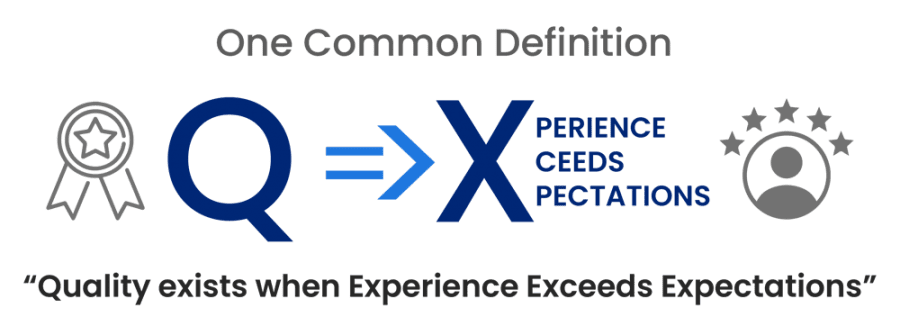 |
QC1 instils Quality-consciousness to design, develop and deliver Experience to always Exceed dynamic (customer) Expectations. It thus mandates Envisaging-efforts to assimilate, aggregate and action these ever-changing expectations. It also prompts to explore and exploit Stakeholder-synergy in this era of co-creation. A sacrosanct inclusion of QC in the work ethos will slowly and steadily establish the QUEST culture.
QC2 – Two Wheels of Quality
After the common definition of Quality comes a simple implementation tool in the form of 2nd Quality Commandment: PDCA and SDCA wheels of Quality.
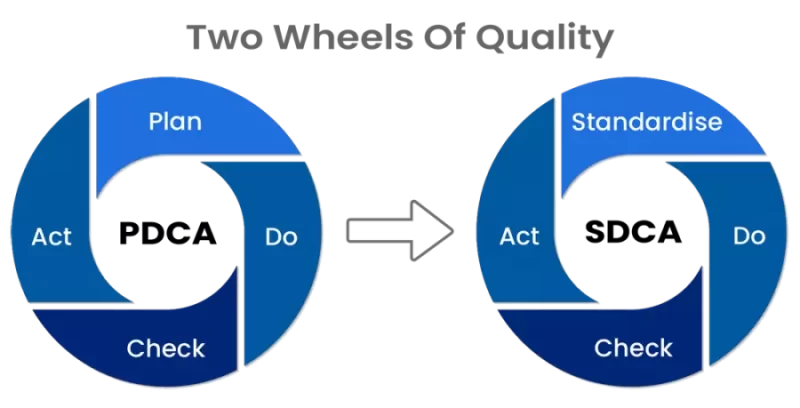 |
Interpretation and implementation of concepts from Dr. W. Edwards Deming’s lectures in Japan in 1950, led to Plan-Do-Check-Act or PDCA cycle. It had been quite pivotal to the Japanese Quality revolution. Typical steps are referred to in the table.
| Quadrant | Steps |
|---|---|
| PLAN |
|
| DO |
|
| CHECK |
|
| ACT |
|
Standardisation and Reflection of ‘Act’ therein, creates Standardise-Do-Check-Act wheel. PDCA drives Quality of Programs/ projects (Policy Deployment) and SDCA ensures Daily Work Management (DWM).
Envisaging-efforts steers ‘Plan’. ‘Standardization’ propels Quality-consciousness. ‘Do’ and ‘Act’ steps emphasise Stakeholder-synergy. Warps and Wefts of these 2 Wheels of Quality will gradually weave QUEST into the fabric of the organisation.
QC3 – Three ‘C’s of Customer Centricity
Much has been said about Customer Centricity. Following three simple but superb quotes, justifiably describe it and its critical drivers – the 3Cs.
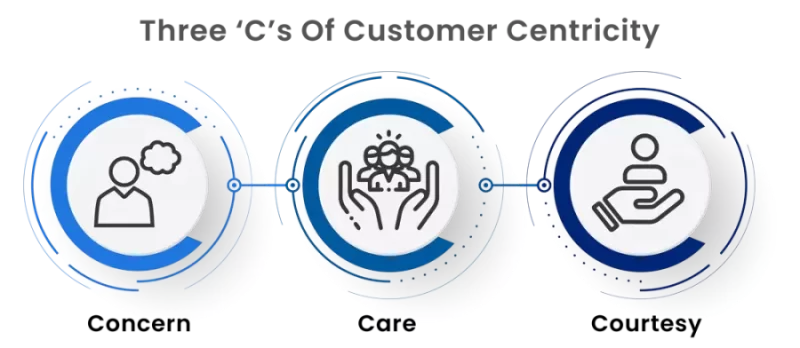 |
Donald Porter’s ‘Customers don’t expect you to be perfect. They do expect you to fix things when they go wrong’, establishes first C-Concern. Being the origin of Customer Centricity, it requires inculcating genuine concern and Envisaging-efforts to find and fix customers’ stated and unstated issues.
‘Your customer doesn’t care how much you know until they know how much you care’, by Damon Richards’ sets second C-Care. A caring attitude individually and collaboratively, leveraging Stakeholder-synergy, along the intricate and interdependent value chain of service delivery, is a definite game-changer.
Mother Teresa’s line, ‘Kind words can be short and easy to speak, but their echoes are truly endless’, crafts third C-Courtesy. Courtesy is cardinal to create long-lasting imprints of service Quality on Customers’ mind. The consciousness of this will fetch a natural, polite and gentle expression of gratitude, for the opportunity to serve them.
Practice to perfect the 3Cs of 3rd Quality Commandment must continue till QUEST is steadfastly engrained on minds and instinctively reflected in actions during the delicate interface with Customers.
QC4 – Four ‘P’s of Moment of Truth
The instance of interface referred above is termed as Moment of Truth, perceived by the customer through Product, Process, Place and most importantly, the People of an organisation.
These 4Ps of 4th Quality Commandment demystify abstractness of Quality. They deploy QC1-‘One Common Definition’, into a concrete set of deliverables, applying principles of QC2-‘2 Wheels of Quality’.
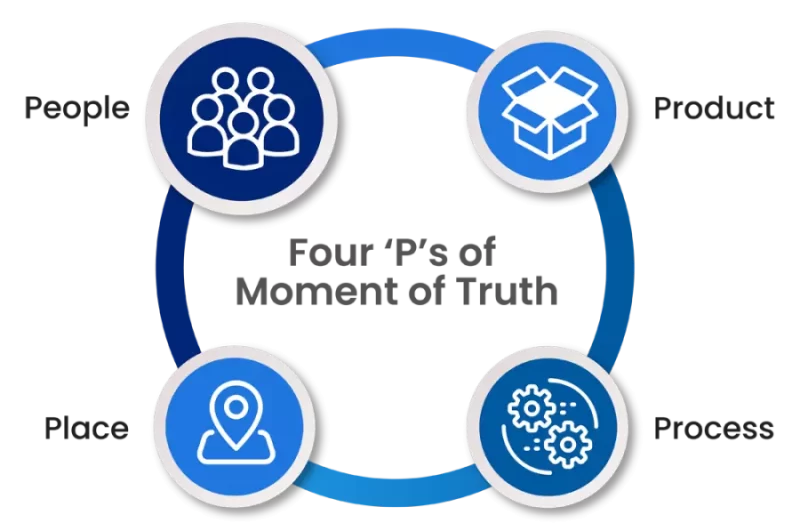 |
As you can appreciate, P-Product is key to tangible customer experience; P-Process steers standardisation and P-(Work) Place, real or virtual, has an intrinsic influence on customer experience.
In the 4P figure, P-People takes pedestal position and prominent pie signifying its implication on other 3Ps, lest their futility. People play a fundamental role in building Quality-Excellence Culture in organisations, like a choirmaster, who synchronises all the (on-stage/ back-stage) elements of the orchestra into an astounding performance.
Regular rhetoric and rituals of 4Ps, till such time they become the innate source of natural responses, is essential for cultivating QUEST.
QC5 – Five Phases of Value Chain
‘Process’ mentioned in QC4 coverts Input from Supplier into Output for Customer. Little rearrangement of underlined letters creates QC5: SIPOC.
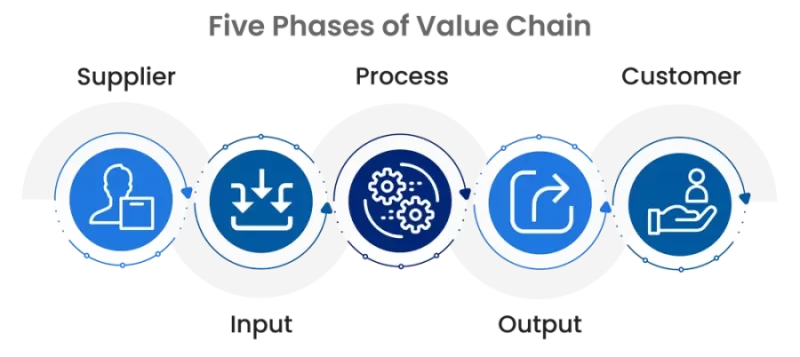 |
This powerful mnemonic structures thoughts and actions into Process-driven – Customer-Centric approach, building on these fundamental constituents of the complex value chain:-
Collecting VoC- Voice of Customer, for expectations initially and experience periodically; Collating them into tangible Output; Converting inputs through Process into this output; Choosing required Inputs and Selecting Suppliers for obtaining inputs.
The letters in ‘bold’ develop into COPIS (not SIPOC). This is perfectly tuned to current customer-centric ‘Market In’ viewpoint (against old ‘Product Out’). However original SIPOC is more popular and still in vogue.
It can help to build a culture of internal Customer/ Supplier within an Organization. Functions, depending on their positions in SIPOC value chain, can be supplier (Upstream) or customer (Downstream). In organisations imbibing this, roles are performed effectively, efficiently and empathetically.
Stable and controlled value chain needs Quality-consciousness; Collecting VoC, designing value-adding processes, selecting suppliers necessitate Envisaging-efforts, and navigating across the value chain requires Stakeholder-synergy. Adoption of SIPOC in day to day work catalyses adaption of QUEST as an organisation’s DNA.
QC6 – Six Serving Honest Men
QC6 arises from Nobel Laureate- Joseph Rudyard Kipling’s famous poem. It conveys a more profound notion of questioning and curiosity. This inherent boon to humankind has been its source of accumulating knowledge to emerge the most dominant species on the planet.
However, this innate ability of curious questioning diminishes as one grows. One gets confined to norms of the world, without questioning their purpose and relevance. Accepting the status quo kills curious questioning and stalls reasoning. Life at work or as an individual is all about solving problems using Rational Questioning & Reasoning Techniques to find answers for developing alternatives and deciding solutions.
| “I KEEP six honest serving-men (They taught me all I knew); Their names are What and Why and When and How and Where and Who.” 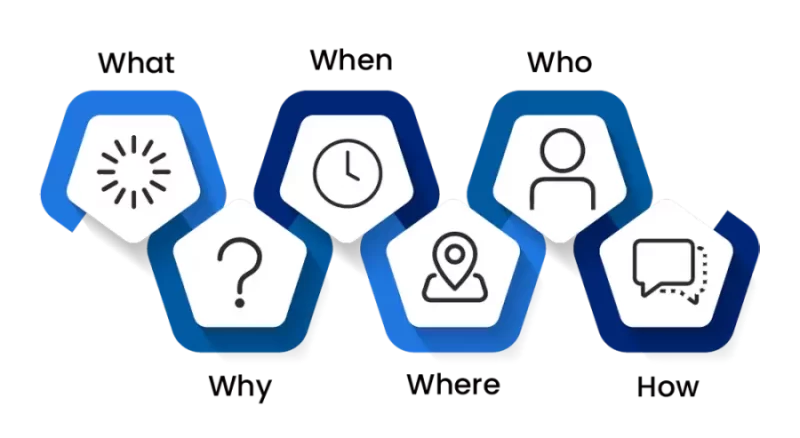 |
The crux of this 1902 poem was embraced by Japanese in the 1960s as “5W-1H”. It proved to be a cornerstone of their successful Quality pursuit, continuing to do so for everyone even today. Substantiated by ‘How much’, ‘What if/ else’, and ‘So what’, it has now evolved into 9 jewels of ’Thinking Crown’.
Some of ‘6 (+3) Serving Men’ assist us to attain Quality-consciousness, while others support us practise Envisaging-efforts, and most help solicit Stakeholder-synergy, to make us inculcate QUEST orientation.
QC7 – Seven Steps of Service Stream
Efficacy of a process or approach is essential to survive in a competitive environment. It differentiates “consistently improving” from “occasionally outstanding”. QC7, an acrostic ‘AWESOME’, articulates otherwise imprecise activities of service delivery, into a systematic approach, blending it with aspects and attitude, which is crucial to thrive too:
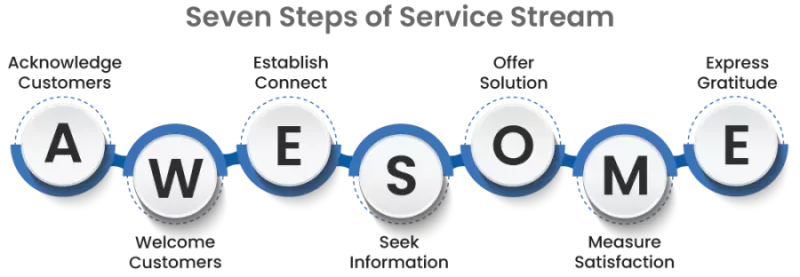 |
Acknowledge Customers: Sense, appreciate Customers’ presence & suggest it by exhibiting positive body language, displaying an honest smile
Welcome Customers: Cheer them with a friendly greeting to set the tone for further interaction. Being genuine and sincere makes it warm & heartfelt, causing a considerable impact and immediate payoff Establish Connect: Break the ice & trigger positive conversations by clever use of pleasantries or polite enquiry into the welfare of Customers to enchant them instantly
Seek Information: Be available, approachable & attentive to Customer’s concerns & queries: stated & latent; Active listening, Gentle questioning & Paraphrasing are effective means for quick cognisance
Offer Solution: Provide information like product/ service, suggestions/ insights & perspective/ knowledge to help Customer decide. Solutions cannot be always delivered but empathy can be
Measure Satisfaction: Ask suitable questions to gauge their experience & establish if Customers’ expectation were met or surpassed. Enhance their experience by asking for any additional assistance
Express Gratitude: Thank them for conveying how much we value customers- our reason for existence. First impression is the last impression but the last impression is the lasting impression. Bidding farewell is the opportunity
Every customers-facing person must use the blueprint of ‘Live Every day-The AWESOME way’ to build an edifice of QUEST.
QC8 – Eight Triggers for Waste Elimination
QC8 focuses on enhancing Efficiency of Customer Service Delivery, by identifying and eliminating waste or all such activities that adds NO value for their money. ‘Waste’ is defined as NVAs (Non Value Adding Activities) and classified into 8 categories:
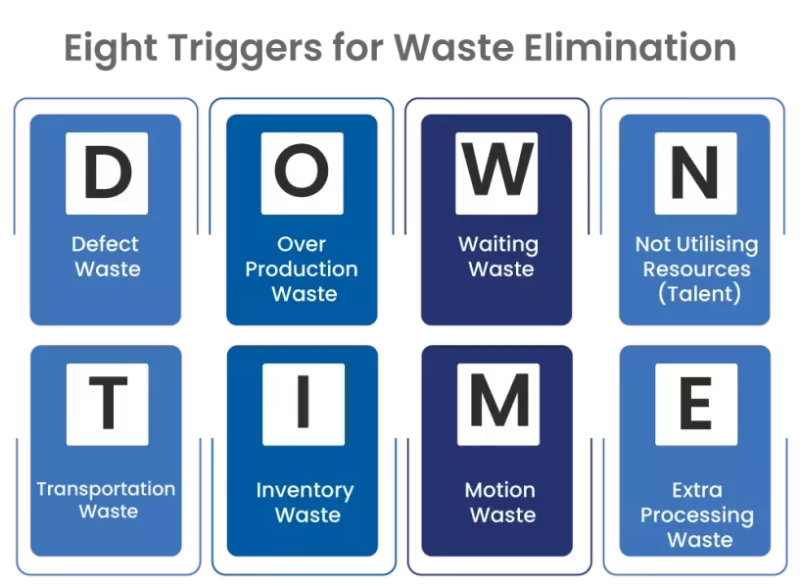 |
Defect Waste: Every defect requires rework, replacement or recovery, it spoils resources and leads to dissatisfied/ lost customers. Various errors, Missing/ Incorrect/ Incomplete information are a few examples.
Over Production Waste is providing too much or too early. Right philosophy is (JIT), Just in Time, and not Just in Case. Few examples are creating reports/ copies that none needs/ uses, use ‘Reply All’ in mails etc.
Waiting Waste: Unutilized Time/ resources while waiting for something, typifies this waste. Few examples: Waiting to be served, Waiting for instructions/ approvals/ information/ decisions/ clarifications etc.
Not Utilising Resources (Talent) is waste particularly of management resources, e.g. not involving right employees to find solutions, information/ best practice black-out, work functions-skill sets mismatch etc.
Transportation Waste: Business pay logistics costs to transport items/ people internally/ externally, it adds no value, e.g. poor layouts, multiple sites movements, insufficient use of tele/video conferencing etc.
Inventory Waste: Inventory or storage of resources has a cost till its final consumption/ full usage, for example too many office supplies, unwanted records in the database, equipment/ facility with low utilisation.
Motion Waste is caused by unwanted movements of man or machine which are not small or as easy to do, e.g. unnecessary movement between work stations, to storage and due to poor office layout etc.
Extra Processing Waste can be illustrated by manual data entry despite electronic one, the same information in multiple formats, Superfluous multiple approvals, higher quality (colour) print when grey is enough) etc.
These eight triggers surely enhance Quality-consciousness, elicit Envisaging-efforts and enrich Stakeholder-synergy across value delivery chain thus foster the QUEST in an organization.
QC9 – Nine Nuggets of Quality
In the figure below, FTR is the core purpose of all quality endeavours. The inner-circle contains two F’s FMEA and F2F – enablers of defect preventive mindset for driving FTR. The outer orbit features six different aspects to ensure FTR.
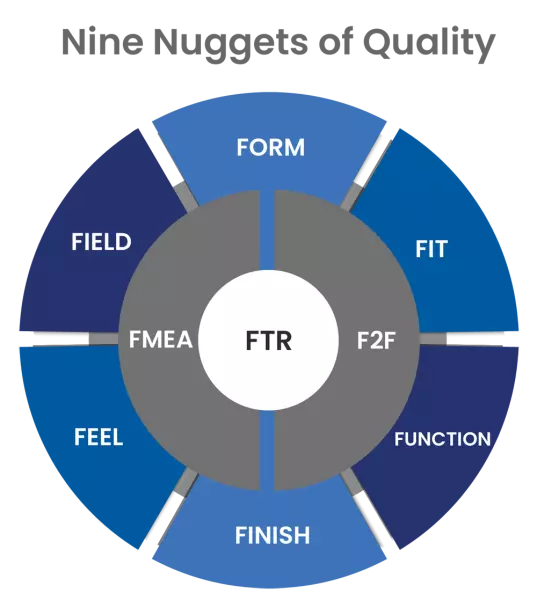 |
FTR – First Time Right drives Quality-consciousness for doing things right, right the first time, every time. FTR echoes QC8 in pursuing the philosophy of Zero Defect to deliver value for money to customers.
FMEA – Failure Mode Effect Analysis encourages Envisaging-efforts. Performed during Design/ Process/ Product/ System development, it identifies potential failure modes and devises controls to prevent defect flow /occurrence.
F2F – Find to Fix: This approach aids us to “hunt” abnormalities during usage of product, process or service delivery and at the workplace. Goes a famous maxim ‘Catch the problem before they catch you’. Use all five senses to find them and sixth sense (mind) to fix.
FORM represents the specification, norms, characteristics, properties and applicable standards etc. desired in product/ service, to addresses customer requirements. ‘Quality is conformance to all such requirements’.
FIT: One of Quality Guru, Joseph M. Juran, defined ‘Quality as Fitness for Use’ which means the effectiveness of systems, processes, design etc. deployed for delivering goods or services that fit customer’s usage.
FUNCTION is the ability of a product (or service) to meet its desired purpose by performing the defined role to deliver the required output. It is an explicit & essential expectations of a customer.
FINISH denotes the aesthetic and external appearance of the product. Modern Quality thinkers like Kano, present two-dimensional Quality Model, 4th/ 5th/ 6th Fs denoting ‘must-be quality’ and 7th/ 8th Fs ‘attractive quality’.
FEEL originates from the “touch & sense” of the product (or service). It mostly encompasses ease & comfort (ergonomics) aspects experienced during the use of the product (or service). It is also called perceptual quality.
FIELD: The characteristics associated with the durability of a product (or service), is the ability for continued optimum desired performance of the product (or service) in the actual operating environment during its life cycle.
Stakeholders are essential elements of organisation’s ecosystem. All the 9F’s will be imperfect without Stakeholder-synergy and so will be the QUEST.
QC10 – Ten Lettered Magic Wand: Engagement
In a complex era of coexistence and efforts for co-creation, the key to success lies in collaboration with the ecosystem or business neighbourhood.
It will be appropriate to mention here, English rendition of famous Bollywood movie dialogue- ‘In our (film) industry, only 3 things work: Entertainment-Entertainment-Entertainment’. This, in Service (or any other) industry, would translate as – ‘In our (Service) industry only 3 things work: Engagement-Engagement-Engagement’. This Engagement revolves around Pax (Customers), Partners & People.
QC10 is indeed a 10 lettered magic wand E N G A G E M E N T, that Energises Neighbourhood to Galvanise Agreed Goals into Execution, or to ‘ENGAGE’. However, it demands enormous efforts and equal energy. And where does one acquire it from?
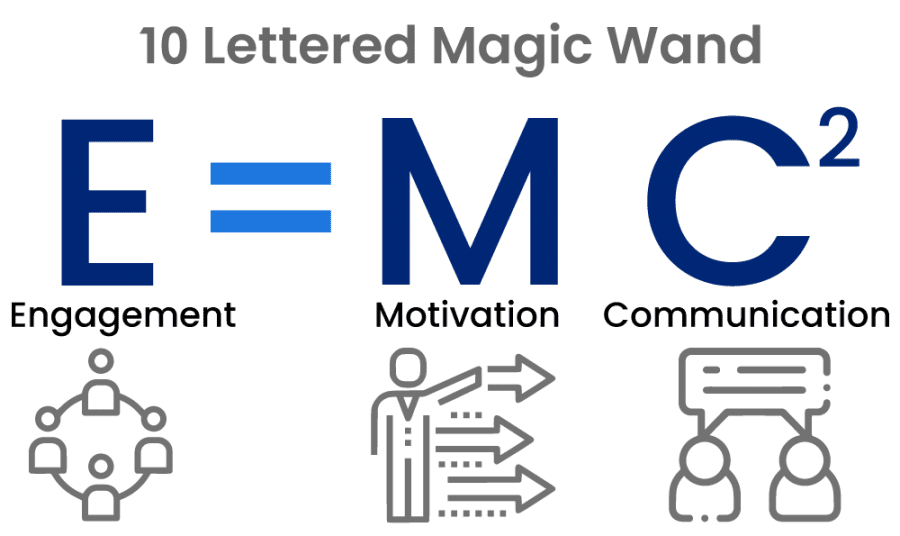 |
Here is the formula in Einstein’s famous equation – E=MC2, which deals with energy. In our case, E is Engagement which equals M – Motivation multiplied by the square of C – Communication. This flashes a chain reaction of engagement, releases massive positive energy and ensures a win-win. In simple words, communicate, communicate with and motivate, People & Partners to pursue the common purpose of existence of ecosystem: Enriching Experience of Pax.
Quality-consciousness and Envisaging-efforts, primarily emphasised in earlier 9QCs, will be sure amplified by Stakeholder-synergy harvested from QC10 to reverberate the QUEST in the neighbourhood.
Making QUEST – The Mantra for & Beyond 2020
The 10 commandments are amply articulated with befitting icons and subtly stitched for ‘Creating Culture of QUEST’ for future-proofing basic service delivery operations of the organisation. Whereas each commandment is unique, they truly complement each other. They attempt to appraise progressive role requirements for Effective, Efficient, and Smart Service Delivery. The catchword QUEST (QUality-consciousness, Envisaging-efforts and STakeholder-synergy) is a common theme harnessing 10 QCs.
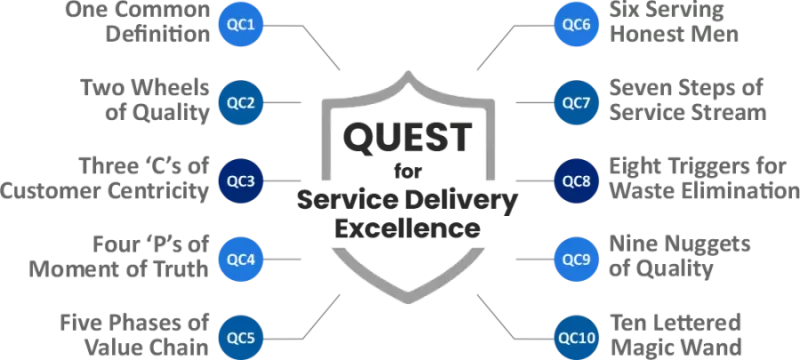 |
Many organisations have Catchwords/ Tag lines which makes them accentuate their underlying philosophy. Organisations take decades, even more, to realise the intent of such highlighters. Embracing 10 QCs tactfully can result in ‘Making QUEST – The Mantra for and beyond 2020’ tacitly.
Call it Mantra or catchword, the crux lies in its mindful and meaningful adoption, individually by everyone, and collectively within the ecosystem, till it is infused in the subconscious and reflected in reflexes. However, it will only be the partial endpoint of cultural transformation around QUEST. The ever-evolving nature of Quality will merit multiple metamorphoses aided by AI, ML and likes of the digital era.
God Bless, All Best for this marathon mission with moving milestones.
Authored by:
Dinesh Bhrushundi
Consultant, Centum Learning Limited


